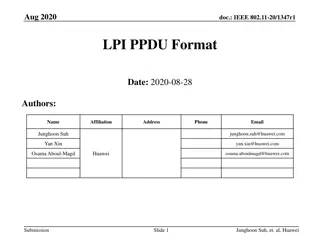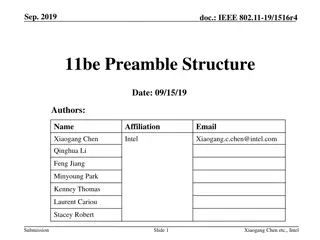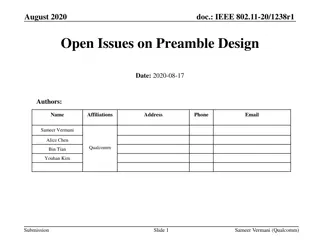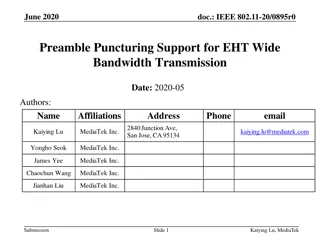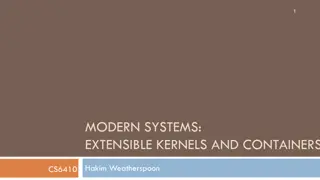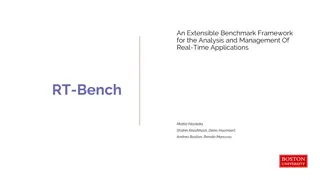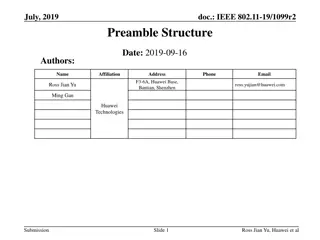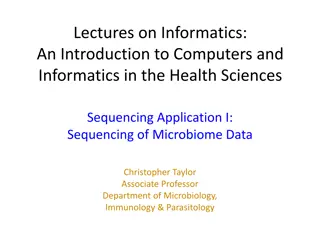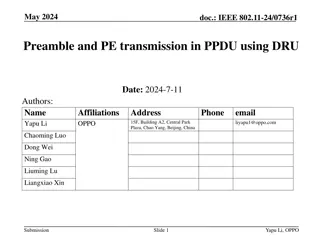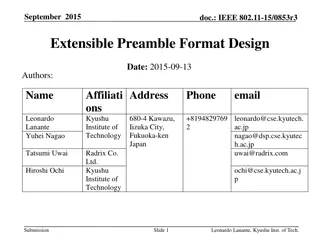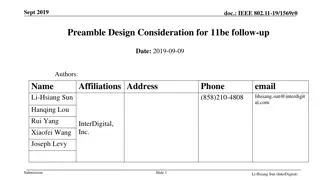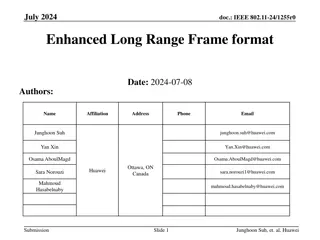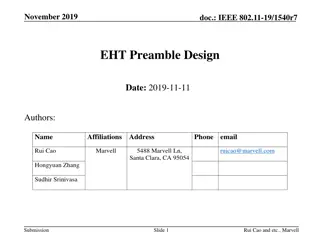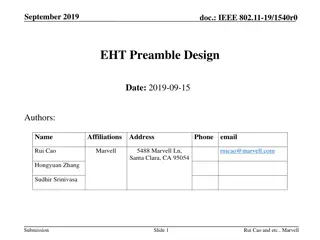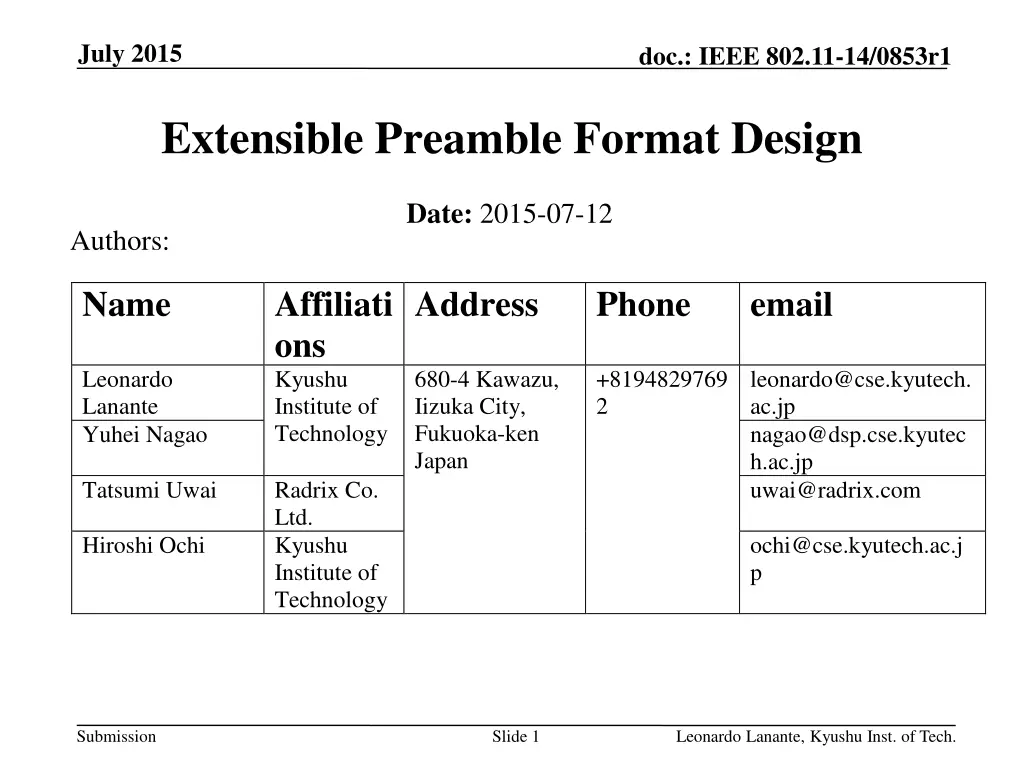
Extensible Preamble Format Design for IEEE 802.11
Explore the proposal for an extensible preamble format designed to address the autodetection challenges in future IEEE 802.11 PHY amendments. The proposal aims to create a straightforward and efficient format for easy implementation and differentiation from previous and upcoming standards.
Download Presentation

Please find below an Image/Link to download the presentation.
The content on the website is provided AS IS for your information and personal use only. It may not be sold, licensed, or shared on other websites without obtaining consent from the author. If you encounter any issues during the download, it is possible that the publisher has removed the file from their server.
You are allowed to download the files provided on this website for personal or commercial use, subject to the condition that they are used lawfully. All files are the property of their respective owners.
The content on the website is provided AS IS for your information and personal use only. It may not be sold, licensed, or shared on other websites without obtaining consent from the author.
E N D
Presentation Transcript
July 2015 doc.: IEEE 802.11-14/0853r1 Extensible Preamble Format Design Date: 2015-07-12 Authors: Name Affiliati ons Kyushu Institute of Technology Radrix Co. Ltd. Kyushu Institute of Technology Address Phone email Leonardo Lanante Yuhei Nagao 680-4 Kawazu, Iizuka City, Fukuoka-ken Japan +8194829769 2 leonardo@cse.kyutech. ac.jp nagao@dsp.cse.kyutec h.ac.jp uwai@radrix.com Tatsumi Uwai Hiroshi Ochi ochi@cse.kyutech.ac.j p Submission Slide 1 Leonardo Lanante, Kyushu Inst. of Tech.
July 2015 doc.: IEEE 802.11-14/0853r1 Summary Every time there is a new amendment requiring a new PHY preamble format, we always run into the problem of how to do the autodetection against all previous PHY preamble formats. We propose to create a new preamble format that is efficient and straightforward extensible for future PHY amendments. There have been a few proposals for the preamble format and its autodetection but they re extensibility is either uncertain or inefficient. Submission Slide 2 Leonardo Lanante, Kyushu Inst. of Tech.
July 2015 doc.: IEEE 802.11-14/0853r1 Proposal- Develop an extensible new preamble format START Step 1: Isolate the New Preamble Format N STEP 1: New Format? Y Step 2: 11ac 11ax and future format detection Autodetection Step 2: Define an extensible encoding for 11ax and future extensions Submission Slide 3 Leonardo Lanante, Kyushu Inst. of Tech.
July 2015 doc.: IEEE 802.11-14/0853r1 Step 1: Isolating the new preamble format HE- SIG2 HE- SIG1 TBD L-LTF L-SIG L-STF BPSK BPSK BPSK 1. By using BPSK in the 2 symbols after L-SIG, we quickly narrow down the option to 11ax+ Legacy with BPSK modulated data 2. To rule out Legacy with BPSK, several approaches can be made [1-2]. CRC check Service Field Check Additional QBPSK symbol at the end of HE-SIG2 Special patterns in HE-SIG1 (Repeated L-SIG, Signatures) Submission Slide 4 Leonardo Lanante, Kyushu Inst. of Tech.
July 2015 doc.: IEEE 802.11-14/0853r1 Step 2: Define an extensible format to separate 11ax+ preamble formats HE- SIG2 HE- SIG1 TBD L-LTF L-SIG L-STF BPSK BPSK BPSK 1 TBD (actual 11ax-SIG bits) Propose a Prefix code for encoding the format 11ax indicator 01 TBD (actual 11bx-SIG bits) 11bx indicator 00 1 TBD (actual 11cx-SIG bits) 11cx indicator Note: 11bx, 11cx, etc. are future extensions Submission Slide 5 Leonardo Lanante, Kyushu Inst. of Tech.
July 2015 doc.: IEEE 802.11-14/0853r1 Benefits of Proposed Step 2 1. With Step 1, 11ax devices can readily distinguish its packet from 11ac and earlier packet formats. However with Step 2, it can also distinguish itself from future extensions. 2. Step 2 can either serve as an additional check for detecting 11ax preambles or a built in spoofing method that can be used by future ammendments. 3. Once the received frame is judged to be of the new format, detections of the future extensions have Accuracy - Equal to the BER of the L-SIG (or HE-SIG). This already has very good accuracy due to the Viterbi decoder. Extensibility- Only one bit overhead for 11ax. Additional bit per future extension. 3. By using a prefix code based encoding, we don t need to allot any bits for extensions that doesn t exist yet. Submission Slide 6 Leonardo Lanante, Kyushu Inst. of Tech.
July 2015 doc.: IEEE 802.11-14/0853r1 References [1] 11-15/0579, Preamble design and auto-detection, Hongyuan Zhang (Marvell) [2] 15/0081, Considerations on 11ax Auto-detection Methods, Jaeyoung Song (KAIST) Submission Slide 7 Leonardo Lanante, Kyushu Inst. of Tech.
July 2015 doc.: IEEE 802.11-14/0853r1 Strawpoll Do you support the idea that the preamble format and autodetection of 11ax shall be directly extensible for future 802.11 extensions. Y/N/A: Submission Slide 8 Leonardo Lanante, Kyushu Inst. of Tech.
July 2015 doc.: IEEE 802.11-14/0853r1 Strawpoll Do you agree to add the following to 11ax SFD: The HE PPDU shall include a TBD number of format indication bits in HE-SIG-A Field. Y/N/A: Submission Slide 9 Leonardo Lanante, Kyushu Inst. of Tech.


